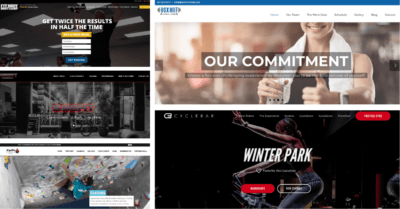Many fitness entrepreneurs think the moment they sign a new client is the moment that they’ve ‘won’ that customer forever.
But the reality is, in a world where up to 40% of new sign-ups will cancel their membership within 12 months, that just ain’t true.
Savvy gym owners understand sign-ups are great, but it’s what happens after that really counts. Because that’s the golden opportunity to transform hesitant newcomers into raving regulars.
The marketing-speak for what happens after a sign-up is known as customer onboarding.
Customer onboarding matters because it’s got the power to boost your retention rate, increase your customer lifetime value and stick smiles on your customer’s faces.
If you’ve been meaning to implement a customer onboarding program but don’t know where to start, this article is for you.
Skip ahead to:
- What is Customer Onboarding?
- How to Develop a Successful Customer Onboarding Process
- Sample Customer Onboarding Checklist
What is Customer Onboarding?
According to the guys over at HubSpot, customer onboarding is:
“The nurturing process that gets new users acquainted with your product. An exceptional customer onboarding program involves step-by-step tutorials, unlimited guidance and support, and milestone celebrations when a customer achieves success through your solution.”
Put simply, onboarding is what you do between a sign-up and a customer success story.
You might be thinking, yeah that sounds well and good, but why should I bother putting time and effort into developing an onboarding program?
Well, here’s why:
Onboarding Boosts Customer Retention & Customer Lifetime Value
It’s hard work to get customers in the door. Much harder than keeping them there.
And according to a Club Industry Report on member engagement and retention, it costs nine times as much to acquire a new member as it does to retain an existing one.
So, while chasing down new customers is important, the real profit is in hanging onto your current ones. In fact, studies show that increasing your retention rate by just 5% can increase profits by between 25% and 95%.
Great onboarding reduces the number of canceled memberships by guiding your new-sign ups over the initial hump that they may face when joining your gym.
Furthermore, by increasing the odds your customers will stick around, you’ll boost your customer lifetime value too, which means you can start spending more to acquire customers.
And when you start spending more to acquire customers, your competition will start quaking in their boots.
Onboarding Creates Advocates for Your Gym
Great onboarding increases the chances that more of your members will reach their goals and be delighted with their results.
And when your customers are happy, they’re much more likely to become advocates for your gym. This is huge because, in an increasingly competitive market, word of mouth marketing is more powerful than ever.
In fact, according to Nielsen, 92% of people trust recommendations from friends and family over any other type of advertising. What’s more 74% of consumers identify word of mouth as a key influencer in their purchasing decisions.
So in a nutshell, properly onboarded customers make happier customers, happier customers make better advocates and better advocates make bigger profits.
Onboarding Boosts Your Gym’s Revenue
Onboarding is a relatively low-cost process to implement. Especially when you consider the returns.
By increasing your retention rate, growing your customer lifetime value and creating passionate advocates, onboarding will help your revenue and profits grow steadily over time.
Greater revenue will allow you to reinvest money into your gym, which helps build your business up over the long-term and present a more attractive offer to potential customers coming down the pipeline.
How to Develop a Successful Customer Onboarding Process
The aim of onboarding is to help new members get acquainted with all that your gym has to offer. Building a successful onboarding process will depend on the specific needs of your sign-ups and the unique culture of your gym.
But while individual onboarding approaches may differ, your objective is always the same: to empower your clients by providing them with the right resources that set them up for success.
To that end, here are the six building blocks that form the basis of a great onboarding experience:
1. Understand Your Customers
Before you do anything, it’s best to have a solid knowledge of your customers. Understanding what obstacles, challenges and pain points they face is the first step towards creating tailored solutions that’ll make up your onboarding program.
The Customer
Engagement Playbook
for Your Fitness
Business
Discover more Use a tool like survey monkey to ask your members about what they found most challenging when joining your gym. Then use the data to determine what issues your onboarding strategy needs to address
2. Develop Your Communication Strategy
It’s amazing the difference that a little communication can make. Did you know that just two monthly interactions between staff and clients has been shown to cut the risk of membership cancellations by 33%?
So first, decide on a communication channel – ideally, it’ll be one that your customers use regularly. It could be e-mail, mobile text or messenger.
Then, choose what kind of content you’ll be sharing with your new members. Use the responses from your survey to provide the most relevant and helpful information.
It might be information about booking classes, workout tips for getting started or introducing the members of your staff. Your content should delight and impress your customers and remind them why they signed up to your great gym in the first place.
Whatever you choose, leverage a platform like Mailchimp or Tatango to automate your onboarding communications. Doing so, allows your new members to receive your messages without you lifting a finger.
Generally, your onboarding flow should run for about 90 days – but don’t worry you don’t need to contact your new members every day – that would likely have the opposite effect of what we’re trying to achieve. Usually, one piece of content each week on top of regular communications works great.
3. Create Customer-Focused Goals
As a fitness professional, you’ve seen how little progress is made when people don’t use goal-setting. Program hopping, nutritional fads, and hours of aimlessly going in circles lead to little or no results.
But goal-setting, on the other hand, allows people to see future possibilities, gives them a plan of action and boosts their motivation, especially when challenges arise.
That’s why it’s essential to incorporate goal setting as part of your onboarding program. By pointing clients in the direction you’ll increase the chances that they’ll achieve success.
Schedule a one-to-one appointment with every new sign-up, but before you do that send them a questionnaire to determine their base level of fitness, current eating habits, workout preferences and what they hope to achieve.
This saves time, increases engagement and allows you to match them with the ideal trainer to help them reach their goals. Work through setting goals using the SMART system for the best results.
Usually creating goals for the six to eight-week mark works a treat. That’s long enough to allow change to happen but short enough to keep even the most apprehensive committed. Check-in and follow up regularly with customers to make sure they feel valued.
4. Encourage New Member Engagement
We’re all social creatures. When we feel like we’re part of the tribe, where people look out for us and are interested in us, we’re much more likely to derive a sense of belonging, importance, and satisfaction.
That’s why getting sign-ups engaged with your current members should be a top priority if you want them to stick around.
Group workouts are a great way to introduce new and veteran members to each other. And they’re effective too – one of the key findings of IHRSA’s 2018 report was that class attendees are 56% less likely to cancel their membership than those who go it alone on free weights or other training equipment. So, hold spaces in your current sell-out classes for new members so they won’t be discouraged.
If you don’t run classes or if your new sign-ups aren’t interested you could try other approaches. Private Facebook groups are free to set up and a fantastic place for members to introduce themselves, support one another and share advice.
Coffee mornings or educational seminars are also low-cost events where members can mingle and get to know one another away from the more pressured training environment. Get creative with and provide multiple touchpoints to and encourage as much interaction in your onboarding program as possible. It’ll pay huge dividends as time goes on.
5. Build a Knowledge Hub
Great onboarding is about empowering new members to have the courage to chase their goals. So often many people struggle with fitness because they don’t understand the basics.
And with access to the internet, there’s now an overwhelming amount of information that can leave newcomers in a state of paralysis by analysis. Keep in mind that working out for the first time can be seriously intimidating.
So, create your own verified source of reliable information for your members. It could be in the form of a blog, a video course, a printed manual or any other medium. It doesn’t have to be crazy in-depth – just answer the most basic questions that keep coming up (Tip: use the responses from your customer survey to design your knowledge hub)
There’s no point in keeping all of your knowledge locked up in your head – get it out there to guide your members along their fitness journey.
6. Evaluate and Adjust
Just like measuring your strength on certain lifts and taking body part measurements can tell you if your training program is working, you need feedback to know how well your onboarding program is working too.
Identify key metrics such as customer churn rate, customer satisfaction, and member engagement. Take stock of what they currently look like before you implement your onboarding program. Then take measurements at regular intervals to see what kind of impact your onboarding efforts are having.
After a few months, follow-up with a full audit of your onboarding program – you might find some things are working well and others are not producing the results you want. Taking time to review and reflect allows you to optimize your onboarding process over time.
Sample Customer Onboarding Checklist
The following is to give you inspiration about what your first customer onboarding process might look like:
- Deliver a welcome email after sign-up (include goals questionnaire)
- Schedule 1-to-1 meeting with best matched trainer (map out their route to success)
- Enroll the new client in the knowledge hub academy (video course/email sequence/PDF)
- Introduce the new client to the manager and other relevant staff
- Introduce new client to other members via private Facebook group
- Email the new client an incentive to join a group fitness class (reserve a spot for them)
- Pair up clinet’s with similar goals as ‘accountability partners’
- Invite new clients to educational seminars and social events
- Follow up every 14 days with clients to find out how they’re settling in.
- Publicly celebrate new customer’s success. (Facebook group, on gym walls etc.)
In Summary
The importance of the interactions between your clients and your gym in the first few weeks of membership can’t be understated.
A great onboarding experience creates an engaging and memorable experience that guides your sign-ups through inevitable challenges and towards their success.
Designing an onboarding program doesn’t involve a huge amount of work – don’t over think it and keep the six basic building blocks outlined above in mind. When properly executed, your gym will benefit from a lower churn rate, more revenue and happier customers.
The Customer
Engagement Playbook
for Your Fitness
Business
connects with its customers on a deeper level than a
simple business and consumer relationship.








